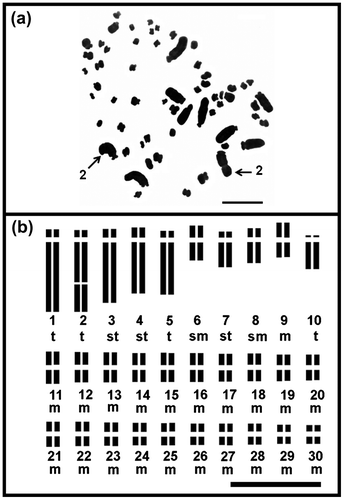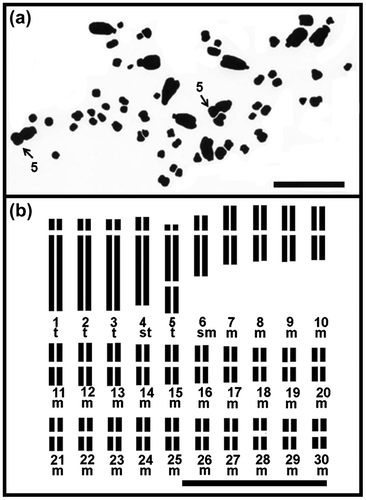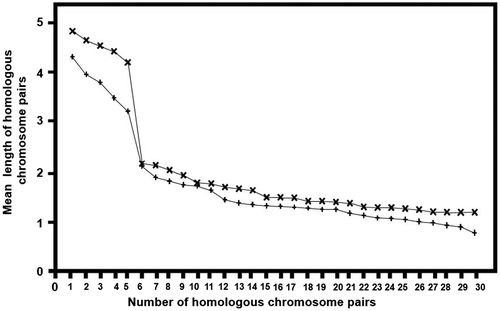Figures & data
Table 1. Provenance and karyotype analysis in diploid Agave angustifolia cultivars (2n = 2x = 60).
Table 2. Arm ratio (r) of homologous chromosome pairs of Agave angustifolia cultivars.
Figure 1. Chromosome of diploid Agave angustifolia “Cimarron” (2n = 2x = 60) from Toliman, Jalisco, Mexico: (a) mitotic metaphase; (b) idiogram. Numbers indicate homologous large chromosome pair with secondary constriction. t: telocentric chromosome, st: subtelocentric chromosome, sm: submetacentric chromosome and m: metacentric chromosome. Bar: 10 μm.

Figure 2. Chromosome of diploid Agave angustifolia “Lineño” (2n = 2x = 60) from Toliman, Jalisco, Mexico: (a) mitotic metaphase; (b) idiogram. Numbers indicate homologous large chromosome pairs with secondary constriction. t: telocentric chromosomes, st: subtelocentric chromosome, sm: submetacentric chromosome and m: metacentric chromosome. Bar: 10 μm.

Table 3. Chromosome analysis of Agave angustifolia cultivars.
Table 4. Results of Tukey–Kramer test on mean length of homologous monoploid chromosome set (x = 30) of Agave angustifolia cultivars.
Figure 3. Mean length of homologous chromosome pairs (x = 30) in Agave angustifolia “Cimarron” (+) and “Lineño” (x). Diploid populations (2n = 2x = 60) from Toliman, Jalisco State, Mexico.

Figure 4. Estimation of nuclear DNA content in Agave angustifolia “Cimarron” and “Lineño” using flow cytometry. (a) Simultaneous analysis of nuclei isolated from A. angustifolia “Cimarron” (2n = 2x = 60) and Zea mays cv. CE-777, used as standard for diploid A. angustifolia “Cimarron”. Peaks 1 and 3 represent G1 and G2 nuclei of Z. mays. Peaks 2 and 4 represent G1 and G2 of A. angustifolia “Cimarron”. (b) Simultaneous analysis of nuclei represents G1 and G2 nuclei of Z. mays. Peaks 2 and 4 represent G1 and G2 of diploid A. angustifolia “Lineño” (2n = 2x = 60) and Z. mays cv. CE-777, used as standard for “Lineño”.

